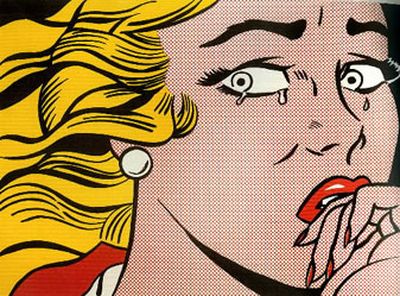Pop! Pow! Blam! It’s Lichtenstein

Whaam! VAROOM! Pow Wow! BLAM!
Look! It’s a cartoon. It’s a newspaper ad. No it’s a Lichtenstein.
Roy Lichtenstein, arguably one of contemporary art’s mega stars, helped define the Pop Art movement.
More than 75 of his images are on view in “Roy Lichtenstein Prints 1956-97: From the Collections of Jordan D. Schnitzer Family Foundation,” in the Washington State University Museum of Art in Pullman.
“Lichtenstein is one of a handful of artists,” said museum director Chris Bruce, “that you just have to see if you care about understanding 20th century art.”
Beginning in the early ‘60s, Lichtenstein borrowed the imagery and look of comic strips for his drawings and paintings. He is widely known for his bold cartoon images and talk balloons painted in flat primary colors and large Ben Day dots – a silk screen technique used in commercial art and advertisements.
“He is one of the great post-war stylist,” Bruce says. “Once you get his work, you will know what Pop Art is.”
American Pop artists – including Allan Kaprow, Claes Oldenburg and Andy Warhol – turned to items from popular, mass-produced consumer culture for attitudes and approaches, as well as for content.
“The Pop movement, especially Lichtenstein and Warhol, came as an incredible change from Abstract Expressionism,” says Bruce. “Where Jackson Pollack and the action painters involved a free form expression, Lichtenstein and Warhol were very machine-like in their expression.
“For people who are casually familiar with Lichtenstein’s work, the exhibit will come of a revolution in terms of the variety of subject matter,” says Bruce.
The breath of the work in the show exemplifies collector Jordan Schnitzer’s appreciation of a retrospective exhibition as a special opportunity to fully explore and understand the way artists evolve over time.
Schnitzer, who lives in Portland, began collecting art more than 20 years ago. He is especially attracted to works that carried an emotional, intellectual or whimsical impact.
His collection includes more than 1,000 pieces from 200 Northwest and American contemporary artists. He has a particular interest in work that chronicle the events, explorations and observations of the major artists in latter half of the 20th century.
“In large part,” he says, “what I’m doing is documenting my life in some way by tracking work that is being made in my time.”
The collection, as a consequence, is rich in the work by Pop and Minimalism artists.
“I love Lichtenstein’s images because of the juxtaposition of simplicity and complexity in each of them,” says Jordan.
“Take ‘Crying Girl’ made in 1963,” he continues. “It is technically a very simple drawing of a girl’s face. Thematically, however, there is power in that image, in her look, the tears and the fear. One can’t helped but be grabbed and shaken.”
Lichtenstein, he continues “was able to create an intellectual tension that few artists of his timeframe were able to do.”
The exhibition does not stop with Lichtenstein stuck in the ‘60s. He went on to explored every print-making medium, producing more than 300 print editions (with multiple runs of each).
“Roy Lichtenstein Prints 1956-97” is an across-the-board exhibit of the many different subjects and genres Lichtenstein chose to embrace during his career. From portrait to abstraction to modern art history, Lichtenstein left no style or subject matter untapped.
The prints from the Schnitzer collection provide an opportunity to witness firsthand a large portion of his life’s work.
“My passion for collecting has turned in to an obsession for sharing them with others,” says Jordan, “It warms my heart more that you can imagine to watch others get excited by seeing these works.”
After leaving Pullman the exhibit travels to the Henry Art Gallery, University of Washington in Seattle; the Jordan Schnitzer Museum of Art, University of Oregon, Eugene; the Las Vegas Museum of Art; Palm Springs Art Museum; and the Mary and Leigh Block Museum of Art at Northwestern University in Evanston, Ill.
“I feel this is one of those exhibits,” says Bruce, “that whoever sees it will not forget it.”